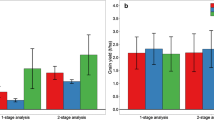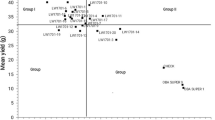Abstract
Key message
CMS-based triticale hybrids showed only marginal midparent heterosis for grain yield and lower dynamic yield stability compared to inbred lines.
Abstract
Hybrids of triticale (×Triticosecale Wittmack) are expected to possess outstanding yield performance and increased dynamic yield stability. The objectives of the present study were to (1) examine the optimum choice of the biometrical model to compare yield stability of hybrids versus lines, (2) investigate whether hybrids exhibit a more pronounced grain yield performance and yield stability, and (3) study optimal strategies to predict yield stability of hybrids. Thirteen female and seven male parental lines and their 91 factorial hybrids as well as 30 commercial lines were evaluated for grain yield in up to 20 environments. Hybrids were produced using a cytoplasmic male sterility (CMS)-inducing cytoplasm that originated from Triticumtimopheevii Zhuk. We found that the choice of the biometrical model can cause contrasting results and concluded that a group-by-environment interaction term should be added to the model when estimating stability variance of hybrids and lines. midparent heterosis for grain yield was on average 3 % with a range from −15.0 to 11.5 %. No hybrid outperformed the best inbred line. Hybrids had, on average, lower dynamic yield stability compared to the inbred lines. Grain yield performance of hybrids could be predicted based on midparent values and general combining ability (GCA)-predicted values. In contrast, stability variance of hybrids could be predicted only based on GCA-predicted values. We speculated that negative effects of the used CMS cytoplasm might be the reason for the low performance and yield stability of the hybrids. For this purpose a detailed study on the reasons for the drawback of the currently existing CMS system in triticale is urgently required comprising also the search of potentially alternative hybridization systems.



Similar content being viewed by others
References
Ahokas H (1979) Cytoplasmic male sterility in barley. Acta Agric Scand 29:219–224
Becker HC (1987) Zur Heritabilität statistischer Maßzahlen für die Ertragssicherheit. VortrPflanzenzüchtg 12:134–144
Becker HC, Leon J (1988) Stability analysis in plant breeding. Plant Breed 101:1–23
Borghi B, Perenzin M (1990) Yield and yield stability of conventional varieties and F1 bread wheat hybrids. J Genet Breed 44:307–310
Bruns R, Peterson CJ (1998) Yield and stability factors associated with hybrid wheat. Euphytica 100:1–5
Butler D, Cullis BR, Gilmour AR, Gogel BJ (2009) ASReml-R, reference manual. Version 3, Queensland department of primary industries and fisheries, Brisbane
Coors JG, Pandey S (1999) The genetics and exploitation of heterosisin crops, ASA, CSSA, and SSSA, Madison
Curtis CA, Lukaszewski AJ (1993) Localization of genes in rye that restore male fertility to hexaploid wheat with timopheevi cytoplasm. Plant Breed 111:106–112
Eberhart ST, Russell WA (1966) Stability parameters for comparing varieties. Crop Sci 6:36–40
Fischer S, Maurer HP, Würschum T, Möhring J, Piepho HP, Schön CC, Thiemt EM, Dhillon BS, Weissmann EA, Melchinger AE, Reif JC (2010) Development of heterotic groups in triticale. Crop Sci 50:584–590
Gowda M, Kling C, Würschum T, Liu W, Maurer HP, Hahn V, Reif JC (2010) Hybrid breeding in durum wheat: heterosis and combining ability. Crop Sci 50:2224–2230
Gowda M, Zhao Y, Maurer HP, Weissmann EA, Würschum T, Reif JC (2013) Best linear unbiased prediction of triticale hybrid performance. Euphytica 191:223–230
Jalaluddin MD, Harrison SA (1993) Repeatability of stability estimators for grain yield in wheat. Crop Sci 33:720–725
Jordaan JP (1996) Hybrid wheat: advances and challenges. In: Reynolds MP, Rajaram S, and McNabA (eds) Increasing yield potential in wheat: breaking the barriers, CIMMYT, Mexico, pp 66–75
Kempe K, Rubtsova M, Gils M (2014) Split-gene system for hybrid wheat seed production. Proc Natl Acad Sci USA 111:9097–9102
Koemel JE, Guenzi AC, Carver BF, Payton ME, Morgan GH, Smith EL (2004) Hybrid and pureline hard winter wheat yield and stability. Crop Sci 44:107–113
Kumar S, Singh O, Rheenen HV, Rao KVS (1998) Repeatability of different stability parameters for grain yield in chickpea. Plant Breed 117:143–146
Léon J (1994) Mating system and the effect of heterogeneity and heterozygosity on phenotypic stability. In: van Ooijen JW, Jansen J (eds) Biometrics in plant breeding: applications of molecular markers. Proceedings of the 9th meeting of the EUCARPIA section biometrics in plant breeding, Wageningen, pp 19–31
Léon J, Becker HC (1988) Repeatability of some statistical measures of phenotypic stability—correlation between single year results and multi years results. Plant Breed 100:137–142
Lin CS, Binns MR, Lefkovitch LP (1986) Stability analysis: where do we stand? Crop Sci 26:894–900
Longin CFH, Mühleisen J, Maurer HP, Zhang H, Gowda M, Reif JC (2012) Hybrid breeding in autogamous cereals. Theor Appl Genet 125:1087–1096
Longin CFH, Gowda M, Mühleisen J, Ebmeyer E, Kazman E, Schachschneider R, Schacht J, Kirchhoff M, Zhao Y, Reif JC (2013) Hybrid wheat: quantitative genetic parameters and consequences for the design of breeding programs. TheorAppl Genet 126:2791–2801
Longin CF, Reif JC, Würschum T (2014) Long-term perspective of hybrid versus line breeding in wheat based on quantitative genetic theory. Theor Appl Genet 127:1635–1641
McMaster GS, Wilhelm WW (1997) Growing degree-days: one equation, two interpretations. Agric For Meteorol 87:291–300
Mühleisen J, Maurer HP, Stiewe G, Bury P, Reif JC (2013a) Hybrid breeding in barley. Crop Sci 53:819–824
Mühleisen J, Reif JC, Maurer HP, Möhring J, Piepho HP (2013b) Visual scorings of drought stress intensity as covariates for improved variety trial analysis. J Agron Crop Sci 199:321–330
Mühleisen J, Piepho HP, Maurer HP, Longin CFH, Reif JC (2014a) Yield stability of hybrids versus lines in wheat, barley, and triticale. Theor Appl Genet 127:309–316
Mühleisen J, Piepho HP, Maurer HP, Zhao Y, Reif JC (2014b) Exploitation of yield stability in barley. Theor Appl Genet 127:1949–1962
Müller BU, Kleinknecht K, Möhring J, Piepho HP (2010) Comparison of spatial models for sugar beet and barley trials. Crop Sci 50:794–802
Oettler G, Tams SH, Utz HF, Bauer E, Melchinger AE (2005) Prospects for hybrid breeding in winter triticale: I. Heterosis and combining ability for agronomic traits in European elite germplasm. Crop Sci 45:1476–1482
Oury FX, Brabant P, Berard P, Pluchard P (2000) Predicting hybrid value in bread wheat: biometric modeling based on a top-cross design. Theor Appl Genet 100:96–104
Peterson CJ, Moffatt JM, Erickson JR (1997) Yield stability of hybrid vs. pureline hard winter wheats in regional performance trials. Crop Sci 37:116–120
Pham HN, Kang MS (1988) Interrelationships among and repeatability of several stability statistics estimated from international maize trials. Crop Sci 28:925–928
Piepho HP, Möhring J, Schulz-Streeck T, Ogutu JO (2012) A stage-wise approach for the analysis of multi-environment trials. Biom J 54:844–860
R Core Team (2014) R: A language and environment for statistical computing. R foundation for statistical computing, Vienna. URL: http://www.R-project.org/
Robert N (2002) Comparison of stability statistics for yield and quality traits in bread wheat. Euphytica 128:333–341
Schrag TA, Möhring J, Maurer HP, Dhillon BS, Melchinger AE, Piepho HP, Sørensen AP, Frisch M (2009) Molecular marker-based prediction of hybrid performance in maize using unbalanced data from multiple experiments with factorial crosses. Theor Appl Genet 118:741–751
Shukla GK (1972) Some statistical aspects of partitioning genotype-environmental components of variability. Heredity 29:237–245
Sneller CH, Kilgore-Norquest L, Dombek D (1997) Repeatability of yield stability statistics in soybean. Crop Sci 37:383–390
Whitford R, Fleury D, Reif JC, Garcia M, Okada T, Korzun V, Langridge P (2013) Hybrid breeding in wheat: technologies to improve hybrid wheat seed production. J Exp Bot 64:5411–5428
Wilson P, Driscoll CJ (1983) Hybrid wheat. In: Frankel R (ed) Heterosis: reappraisal of theory and practice. Monogr Theor Appl. Genet, vol 6. Springer, New York, pp 94–123
Zhao Y, Mette MF, Reif JC (2014) Genomic selection in hybrid breeding. Plant Breed. doi:10.1111/pbr.12231
Acknowledgments
We thank Jens Möhring for statistical consulting. Jonathan Mühleisen was supported by BMELV/BLE withinthe „Züchtung von Triticalesorten für extreme Umwelten—eine Frage des Sortentyps?“ project (Grant ID: 2814502410).
Conflict of interest
The authors declare that they have no conflict of interest.
Author information
Authors and Affiliations
Corresponding author
Additional information
Communicated by Ian Mackay.
Electronic supplementary material
Below is the link to the electronic supplementary material.
Rights and permissions
About this article
Cite this article
Mühleisen, J., Piepho, HP., Maurer, H.P. et al. Yield performance and stability of CMS-based triticale hybrids. Theor Appl Genet 128, 291–301 (2015). https://doi.org/10.1007/s00122-014-2429-1
Received:
Accepted:
Published:
Issue Date:
DOI: https://doi.org/10.1007/s00122-014-2429-1




